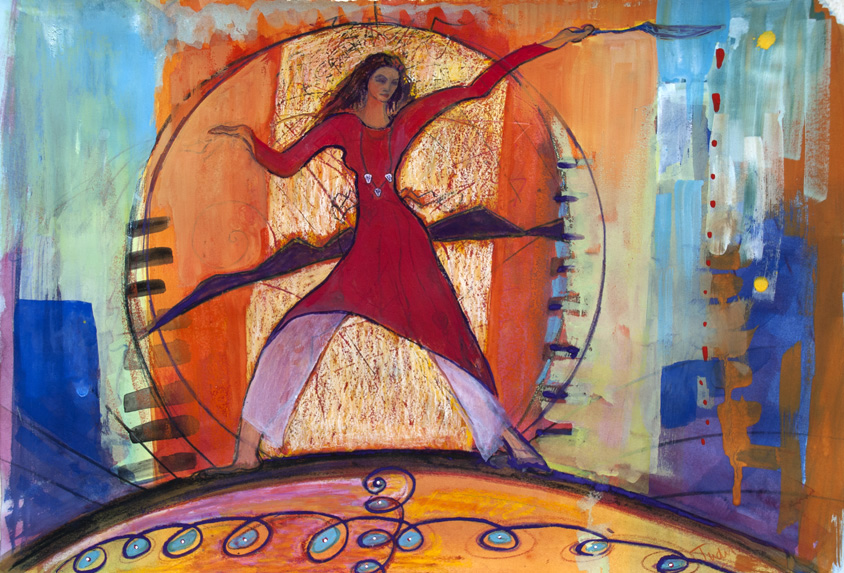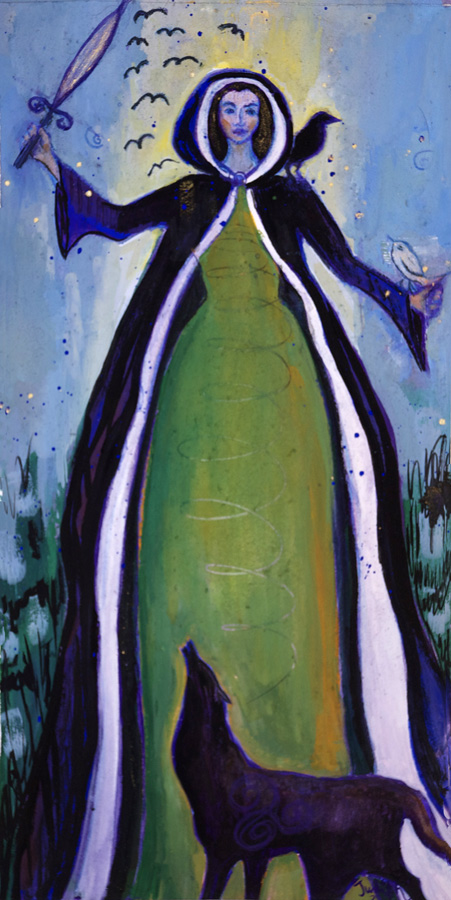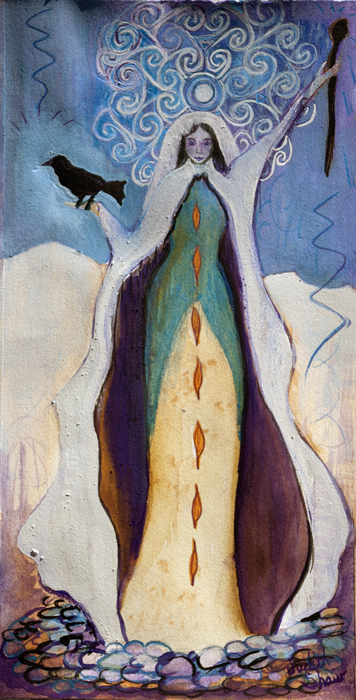I always approach the Dark Goddesses with trepidation, preferring to focus on the bright, life affirming aspects of the Goddess. Yet now I find that the difficult break-downs and violent conditions of these days are calling me to explore the terrifying aspects of the ones called “Dark Goddesses.”
But who are the Dark Goddesses and why are they called dark? That question is one of controversy within the Goddess community. Carol Christ has written that the Dark Goddess only exists as a projection of patriarchal values onto the Goddess, turning the Goddess into a force of war and terror, in particular the War Goddesses found in various cultures. Christ views war as an abnormal desire for the Goddess. Whereas others view the Dark Goddess as a part of the one Great Goddess, who encompasses all.

Certainly Christ’s view has great validity. Yet I also feel that the Dark Goddesses, found in myths and legends from all around the world, are called dark because they deal with the more difficult and frightening parts of life. The Dark Goddesses, with qualities that are mysterious, magical, chaotic, destructive, violent and transformational bring a wholistic understanding of ourselves and of nature. They are wild and untamed.
The dark goddesses are warrior goddesses called upon to destroy evil and cleanse the land.
Kali Ma and The Morrigan
Kali Ma
Hindu Goddess, Kali Ma – the Dark Mother – is one of the most terrifying goddesses of all. Consort to Shiva, she is the destroyer of the world. It is written in the Devi Mahatmya that Kali sprang forth from the anger of Durga – Hindu Mother Goddess – during her battle with the demon Raktabija (“Blood-Seed”). Durga was overwhelmed because, as each drop of Raktabija’s blood hit the ground, a new demon emerged. Her anger created Kali – ferocious, knife-wielding, and terrifying – who then slayed Raktabija and his demon-blood offspring. Numerous stories of Kali’s murderous rampages fill Hindu literature. Shiva was the one who could stop her destructiveness.
Her iconography is both formidable and contradictory. Naked and bloodthirsty with a lolling tongue, she wears a necklace of skulls and a skirt of human arms. She is depicted as deep blue to black and stands over the white corpse of her consort Shiva.

Generally depicted with four arms – one holds a sword, another a severed head, the third signs “fear not” whereas the fourth beckons a blessing of bliss – she is a goddess of creation, preservation and destruction. She reminds us of the impermanence of this physical world.
She is wild, destructive and chaotic. Her name means darkness. She is the eternal night, symbolizing timelessness and the endless void. Often depicted covered with ashes, she dances madly to the drumbeat of death.
Kali is the force that disrupts a corrupt society, destroys ignorance and sin, and opens the path for new beginnings – blessing those who seek knowledge. She is the mother who gives life – the Creator – and then takes it away – the Annihilator. She rules over birth and death.
The Morrigan
The Morrigan is a complex goddess whose name can be seen as a title given either to three different goddesses or to three aspects of the same goddess. In her aspect as Neaim, she was seen shrieking and flying over battlefields, striking terror and confusion into men’s hearts, often causing them to either fall dead from fear or to turn upon each other in confusion. As Badb, she is a flock of crows warning of a great battle or feasting on the slain warriors. As Macha, she takes on the most human of her forms, taking a human husband and increasing his wealth. But even as wife and mother her prophesy is of war and death as seen in Macha’s curse on the Ulstermen, dooming them to failure in battle after they disrespected and harmed her.
The Morrigan never starts wars. She witnesses them, often predicting who will fall in battle as the Washer at the Ford. She reminds us that though chaos and darkness are part of the flux and flow of life we alone have chosen the path of war. When we face overwhelming challenges, the Morrigan, with her power of life and death, guides us in gaining access to our own inner strength.
The dark goddesses bring us the chaos of transformation and the pain and subsequent acceptance of death.
The Cailleach and Hekate
The Cailleach
Called the Veiled One, The Cailleach is an ancient Goddess whose origins are concealed. Known as Goddess of Death, Dark Mother and the Hag of Winter, she was worshipped in the British Isles long before the Celts arrived. Over time her name came to mean “old wife” or “old woman.” And yet she was thought to never grow old; to be an all powerful, ageless, Goddess of Transformation.
As the Dark Mother, The Cailleach ushers in the winter – which must have been a terrifying time in the ancient days without electricity or central heat – while reigning over our dreams and inner realities. She wields power over the seasons and the weather. While walking the land she unleashes violent, chaotic storms with her slachdam, the Druidic rod. She leaps from mountaintop to mountaintop, dropping rocks, creating sacred hills.
The Cailleach – ruling over transformation, death and rebirth, and the hidden worlds – guides us in overcoming the fear of darkness and death.
Greek Goddess Hekate
Hekate was originally a chthonic goddess, emanating from Earth – A Mother Goddess whose soul fuels the world. She existed long before the Greeks claimed her as their own. She ruled many domains – the night, the moon, dogs and creatures of the night, marriage and childbirth, agriculture and the crossroads including, doorways and entrances to public and private spaces. She often carries a torch to light the way in the darkness.
As Goddess of the Crossroads, she provides aide through any life changing event. She rules over the liminal spaces and birth, death and rebirth. As Breaker of the Chains she releases you from whatever ties bind you negatively. She is also known as the Keeper of the Keys, believed by some to hold the keys to the Gates of the Underworld. When angered by mistreatment of women, children and the home she was believed to open the gates, releasing chaos in the form of a horde of wild women and terrifying creatures.

By the 5th century BCE she was changed from a much loved and helpful goddess into a more malevolent force, becoming a Goddess of Witchcraft, the Night, The Dark Moon and the Underworld. She was often depicted with three heads or three bodies – the better to see all possibilities of the converging roads. Some depictions of Hekate give her a terrifying appearance with three heads of a horse, a dog and a lion.
Hekate is the wild woman more comfortable on the fringes, who resists and persists, who lives her truth without apology or compromise. She evokes the very essence of life and death.
Read Part 2 tomorrow to discover some of the world’s oldest dark goddesses and my thoughts on what the dark goddesses can offer us today.
Sources: The Mystica, Ultraculture, Britannica, Bust, World History Encyclopedia
The Celtic Goddess Oracle Deck is still available. Order your deck here.




Thank you for this wonderful post and the gorgeous paintings. I’ve actually always loved these goddesses the most. They reflect the real complexity and full experience of life. They are like the friends you can tell anything to and who will be there for you in your hardest times. They seem like they know the troubles that human life always involves because they have been there. At the same time, they also represent rebirth and emerging from what may seem like destruction into new ways of being, which is another wonderful lesson for us all to keep going, even when life is a challenge.
LikeLiked by 2 people
great point Carolyn – they do reflect the complexity of human life
LikeLike
Carolyn,
Absolutely true! I think many of the dark goddesses also are the ones who hold the echo of the original Mother Goddess – she who encompassed the true complexity of life – who resided in human hearts long before the patriarchal consciousness of domination and control took over the world. I feel that coupled with the negative spin placed on them and their awesome power, they frightened me in the past but I am now ready to incorporate their wisdom.
LikeLike
WOW Judith – stupendously beautiful paintings – so powerful – I had to keep going back to look at each one – The Morrigan is my favorite – but they all move me deeply… and seem ‘true’ in some indefinable way… The Hindu goddess Kali has a place I am sure but I think it might be better to go as parallel as possible with this dark goddess…. yet with today’s dissolution and destruction upon us, I think it’s necessary to develop relationships with these dark figures – we need desperately to learn how to negotiate the dark…and the unknown. Hecate, goddess of the crossroads is one that I have invoked at various times in my life… Kali’s violence scares me. I think it’s important to honor this figures though – and this may be my bias against war? – I shy away from the warrior aspect -just to patriarchal for me – Warrior women like TEWA united – I’m guessing you are familiar with this organization? – take a position of power that does not give into violence and hatred – this doesn’t mean denying its terrible reality -but working with it – and dark goddesses in my way of thinking could help a lot here.
LikeLike
Sara,
Yea, Kali is really terrifying and hard to approach. I have not yet done a deep enough dive into her mythology to discover if she had roots in Hindu consciousness before becoming Shiva’s consort. Though her being created from the Mother Goddess’s anger at a demon terrorizing the world does give a hint. More than likely Kali would be one of the goddesses Carol would characterize as being an unnatural manifestation of Goddess – a projection of patriarchal values onto the Goddess, turning the Goddess into a force of war and terror. If my supposition is correct I would agree. I sorely miss Carol’s input into our discussions here. She was never one to parse words. But as patriarchal values have overtaken the world it is important to understand the dark forces represented by these goddesses for sure.
LikeLiked by 1 person
Agreed… and I too miss Carol so much and believe that she was right about the demonizing of the dark goddesses – I am NOT saying that they are benign in any way but this warrior stuff – well – we know it’s patriarchy – Kali, for example is just too dark in my opinion – rage and hatred beget more of the same – there’s no restraint there at all.
LikeLiked by 1 person
Here’s info on TEWA United… came out at same time Oppenheimer flip did… the other side of the story…
Together we are Beloved Community. Together we can grow a Culture of Peace.
LEARN ABOUT OUR SIDE OF THE STORY
Video and Audio
Los Alamos, New Mexico and Sacred Native Lands (featuring Marian Naranjo)
The Shadow on the Hill
RadioActive: Nuclear Boom with Petuuch Gilbert and Marian Naranjo
Dmitri Brown, Tewa History of the Manhattan Project
Dismantling the Nuclear Beast — this 12-part video playlist documents the landmark 2017 symposium held at University of New Mexico. Elder Kathy Sanchez of Tewa Women United speaks on the Saturday/Part 5 video.
The Grandmothers Circle: Elder Kathy ‘Wan Povi’ Sanchez and Heather Bryan In this episode Elder Kathy talks about growing up in close proximity to the Los Alamos National Laboratory which was built in her community’s sacred mountains and where nuclear waste was stored in traditional ceremonial kivas.
LikeLike
Thanks for that info on TEWA United. New Mexico has certainly become a sacrifice zone in the insanity of war. Not only do we have the labs which develop and store nuclear weapons, we also got stuck with WIPP where nuclear waste from all around the country is stored in the sacred womb of our mother. I suppose all the brown people here made it an excellent choice as dumping ground and earth destruction for our white supremacist government. The scientists who worked at Los Alamos during the development of the bomb and the Cold War have all received huge payments for possible health damage from radiation. Yet the poor indigenous and Hispanic folks who lived off the land around White Sands have still received nothing. I have a friend who grew up around there and she has lost many, many family members to cancer.
Have you seen Oppenheimer yet? I understand it takes an anti-nuclear stand but I have a resistance to seeing it.
LikeLiked by 1 person
Having lived in NM having been to Los Alamos – by the way a beautiful place but the lab of course is off limits to the public – the military might feeling is so strong there still… and yes I know the Indigenous people have received nothing – are we surprised – we still treat our Native peoples as if they don’t even exist. And yes I have seen Oppenheimer’s movie… I’m not sure it takes an antinuclear stand but it does present the other side of Oppenheimer’s story and it highlighted for me the importance of seeing how patriarchal power corrupts -while humanizing one person’s conflicting feelings and actions – too many blame Oppenheimer – if it hadn’t been him patriarchy would have found someone else…the BAD part of the movie is that Native peoples are not in the picture. Period. Just one phrase at the end _give it (the land) back to the Indians)
LikeLike
Hi Judith. Will you be covering Sehkmet? Also another dark Goddess. She was asked by the Gods to rid the world of evil and she got a little out of control. She was calmed by a beer tinted red and spread upon her path to which she drank and calmed down. She was also honored as a healer. I look to Sehkmet during these times when evil, darkness, division, war and hate invade world culture. Her lesson for women is how to use our anger in a positive way.
LikeLike
Hi Jan,
I will be covering Sehkmet but not in this 2 part post of today and tomorrow. These 2 parts are just the beginning on my exploration into those called Dark Goddesses. My own soul urges are calling me to look more deeply into the issues and lessons of these goddesses. I think it will become a book.
That’s an amazing story about her being calmed with red-tinted beer. I only know a little about Sehkmet – mainly from when I was exploring the myth and symbolism of Lion. I look forward to learning more.
LikeLike